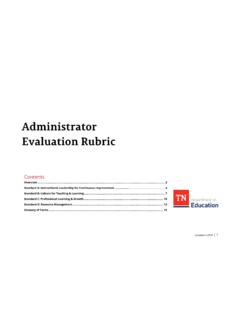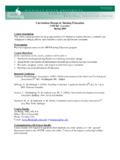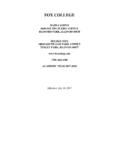Transcription of Administrator Evaluation Rubric - TEAM-TN
1 Updated | 1 Administrator Evaluation RubricContents Overview .. 2 Standard A: Instructional Leadership for Continuous Improvement ..4 Standard B: Culture for Teaching & Learning .. 7 Standard C: Professional Learning & Growth .. 10 Standard D: Resource Management .. 13 Glossary of Terms .. 15 Updated | 2 Overview Tennessee Instructional Leadership standards (TILS) Recognizing the importance of engaging in a continuous improvement process, Tennessee seeks to transform what it means to be an effective instructional leader at all phases of a leader s career. This aim is accomplished by setting high standards for effective leadership based upon research and best practices, supporting leaders to reach those standards , and empowering districts to build a network of exceptional instructional leaders who get results.
2 The Tennessee Instructional Leadership standards (TILS) establish the structural framework of the Administrator Evaluation Rubric by defining a set of indicators and detailed descriptors that provide a clear set of expectations to schools and districts. The Rubric is designed to help instructional leaders develop the type of leadership practices directly related to substantial gains in student achievement. Moreover, the leadership practices embedded in the indicators and descriptors are largely tied to the indirect, but vital, role and impact school leaders have on student achievement. Just as the TILS do not include separate areas to address ethical issues, the Rubric does not separate these areas by indicator and descriptor.
3 The premise is the same with the Rubric as with the standards attributes such as honesty, respect, sound judgment, commitment, fairness, compassion, work ethic, and a genuine belief that all children can learn and grow contribute to the foundation of ethical behavior connected to leadership. The Administrator Evaluation Rubric Approved by the State Board of Education as a tool usedto guide a fair and transparent Administrator Evaluation Developed to establish a culture of support forinstructional leaders Intended to help engage educators in reflective dialogueamong and between peers and evaluators to improvepractice Used to support school leaders and those who supportschool leaders in acknowledging a leader s effectivepractices and results Supportive of a leader s opportunities for improvement,offering guidance on professional growth and learning foroneself and for other educatorsThe Administrator Evaluation Rubric is A checklist.
4 But should be used to weigh thepreponderance of evidence over time against the levels ofpractice defined in the indicators and descriptors Inclusive of all salient aspects of a school leader s role,rather it focuses primarily on the dimensions ofleadership most directly linked to managing teachereffectiveness and increasing student achievement Meant to address areas of performance related topersonal conduct as described in district and statepoliciesBegin with the End in Mind: The Importance of Vision In Tennessee, it is expected that the vision of the school, developed in collaboration with multiple partners and aligned with the district s vision, will drive the actions demonstrated in the Updated | 3 indicators and descriptors in this Rubric over time to increase student achievement.
5 The vision provides a powerful communication and coalescing tool for all stakeholders in the school, creating a word picture of what is to be created and maintained. Crafting an exemplary vision requires asking an essential question: When a vision for continuous improvement, culture conducive to teaching and learning, and professional learning and growth ( standards A, B, and C) has been developed and implemented, what will be different for: your students? your teachers? your school? your parents?An exemplary visioning process occurs when school leaders jointly develop a vision for continuous improvement, contextualized through a) a vision for a culture conducive to teaching and learning and b) a vision for professional learning and growth.
6 The resulting overarching school vision thus exhibits and requires: collaboration with key partners to identify and enactclear, measurable, annual goals; linkage to goals that support student achievement, gapclosure, and college and career readiness with evidenceof growth; communication to nearly all stakeholders; modeling of personal commitment to continuousimprovement and a culture conducive to teaching andlearning; and modeling of school-wide beliefs in professional learningand growthResearch Supporting the Administrator Evaluation Rubric In collaboration with the superintendents , supervisors and principals study councils, the drafting process for the Administrator Evaluation Rubric was largely informed by administrators throughout the state whose suggestions, questions, and concerns regarding the Rubric s language were strongly considered during the development of all iterations of the draft.
7 In addition to input from colleagues statewide, the following research supports the content of the Rubric : American Institutes for Research s The Ripple Effect, 2012 Georgia Department of Education s Leader KeysEffectiveness System, 2012 Indiana Department of Education s Principal EffectivenessRubric, 2013 ISLLC s Educational Leadership Policy standards , 2008 James Stronge s Principal Evaluation , 2012 Kim Marshall s Principal Evaluation Rubrics, 2012 Tennessee s standards for Professional Learning, 2012 McREL s Principal Evaluation System, 2009 New Leaders Urban Excellence Framework, 2011 Stronge, Richard, and Catano s Qualities of EffectivePrincipals, 2008 Tennessee s Teacher Leader standards , 2011 Waters, Marzano, and McNulty s Balanced Leadership.
8 What 30 Years of Research Tells us about the Effect ofLeadership on Student Achievement, 2003 Updated | 4 Standard A: Instructional Leadership for Continuous Improvement Good leadership is not about you. It is about what you leave In the process of improvement, it is almost inevitable that significant barriers will arise. Great leaders learn to build trenches under barriers and find ladders to use to climb over them. Joseph Murphy, Essential Lessons for School Leaders, 2011 Indicator 5 3 1 Possible Sources of Evidence A1. Capacity Building Builds capacity of educators to provide all students a rigorous curriculum, aligned with Tennessee state standards Utilizes shared leadership practices to build capacity of nearly all educators for: Developing an accurateunderstanding of Tennessee-adopted standards andinstructional practices Studying, analyzing, and evaluatingapproved curriculum resources, including texts Maintaining shared accountabilitywhen making needed adjustmentsto deepen classroom rigor Maintaining a system formonitoring student work for rigor and curriculum alignment Implementing on-going strategiesand feedback for peersBuilds capacity among educators for.
9 Developing an accurateunderstanding of Tennessee-adopted standards andinstructional practices Demonstrating fidelity to state anddistrict-approved curriculumstandards Studying, analyzing, and evaluatingapproved curriculum resources, including texts Establishing a system formonitoring student work for rigorand curriculum alignment Establishing collectiveaccountability when makingneeded adjustments to deepenclassroom rigorBuilds limited or no capacity among educators for: Developing educatorunderstanding of Tennessee-adopted standards andinstructional practices Demonstrating fidelity to state anddistrict-approved standards Studying, analyzing, and evaluatingapproved curriculum resources Establishing a system formonitoring student work for rigor Establishing collectiveaccountability when makingneeded adjustments to deepenclassroom rigorPractice/Observation Lesson plans and feedback on theplans Agendas and meeting notes fromProfessional Learning Communities Course offerings (range of levelsand types Advanced Placement and Dual Enrollment offerings forhigh schools)Outcomes Demonstrated growth on observations Met or exceeded goals for.
10 Ostudent achievementogap closureocollege/career readiness TVAASU pdated | 5 Indicator 5 3 1 Possible Sources of Evidence A2. Data Analysis & Use Collaborates with educators to analyze and use multiple forms of data throughout the year to establish specific goals and strategies targeting student achievement and growth Utilizes shared leadership practices and structures: Builds capacity among nearly all educators for analyzing and using multiple sources of student, educator, and school-wide data Develops and monitors a school-wide data plan that includes a) student progress tracking; b) establishing specific strategies to meet or exceed academic and behavioral growth and achievement goals; c) baseline comparisons to benchmarks throughout the year.













